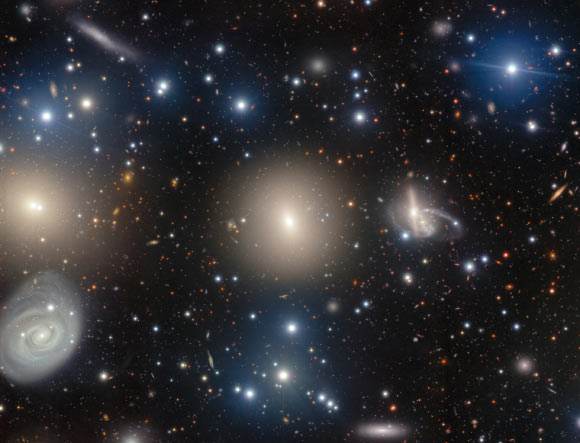Gemini North Telescope Focuses on Giant Elliptical Galaxy in Perseus Cluster
Top Stories Tamfitronics
Using the Gemini Multi-Object Spectrograph (GMOS) on the Gemini North telescope at NSF’s International Gemini Observatory, operated by NOIRLab, astronomers have captured a stunning image of NGC 1270 and several other galaxies in the central region of the enormous Perseus galaxy cluster.

NGC 1270 is just one member of the Perseus cluster, an enormous group of thousands of galaxies that lies around 240 million light-years from Earth in the constellation of Perseus. Image credit: International Gemini Observatory / NOIRLab / NSF / AURA / J. Miller & M. Rodriguez, International Gemini Observatory & NSF NOIRLab / T.A. Rector, University of Alaska Anchorage & NSF NOIRLab / M. Zamani, NSF NOIRLab / PI: Jisu Kang, Seoul National University.
NGC 1270 is located about 250 million light-years away in the constellation of Perseus.
This elliptical galaxy was discovered by the German astronomer Heinrich d’Arrest on February 14, 1863.
Also known as LEDA 12350 or UGC 2660, NGC 1270 has an estimated age of about 11 billion years.
It is a member of a group of thousands of galaxies called the Perseus cluster.
“It’s astonishing to think that when NGC 1270 was first discovered in 1863 it was not widely accepted that other galaxies even existed,” the NOIRLab astronomers said.
“Many of the objects that are now known to be galaxies were initially described as nebulae, owing to their cloudy, amorphous appearance.”
“The idea that they are entities of a similar size to our own Milky Way, or ‘island Universes’ as Immanuel Kant called them, was speculated on by several astronomers throughout history, but was not proven.”
“Instead, many thought they were smaller objects on the outskirts of the Milky Way, which many believed to comprise most or all of the Universe.”
“The nature of these mysterious objects and the size of the Universe were the subjects of astronomy’s famous Great Debate, held in 1920 between astronomers Heber Curtis and Harlow Shapley.”
“The debate remained unsettled until 1924 when Edwin Hubble, using the Hooker telescope at Mount Wilson Observatory, observed stars within some of the nebulae to calculate how far they were from Earth. The results were decisive; they were far beyond the Milky Way.”
“Astronomers’ notion of the cosmos underwent a dramatic shift, now populated with innumerable strange, far-off galaxies as large and complex as our own.”
“As imaging techniques have improved, piercing ever more deeply into space, astronomers have been able to look closer and closer at these ‘island Universes’ to deduce what they might be like,” they said.
“For instance, researchers have observed powerful electromagnetic energy emanating from the heart of NGC 1270, suggesting that it harbors a frantically feeding supermassive black hole.”
“This characteristic is seen in around 10% of galaxies and is detectable via the presence of an accretion disk — an intense vortex of matter swirling around and gradually being devoured by the central black hole.”
“It’s not only the individual galaxies that astronomers are interested in; hints at many ongoing mysteries lie in their relationship to and interactions with one another.”
“For example, the fact that huge groups like the Perseus cluster exist at all points to the presence of the enigmatic substance we call dark matter.”
“If there were no such invisible, gravitationally interactive material, then astronomers believe galaxies would be spread more or less evenly across space rather than collecting into densely populated clusters.”
“Current theories suggest that an invisible web of dark matter draws galaxies together at the intersections between its colossal tendrils, where its gravitational pull is strongest,” they added.
“Although dark matter is invoked to explain observed cosmic structures, the nature of the substance itself remains elusive.”
“As we look at images like this one, and consider the strides made in our understanding over the past century, we can sense a tantalizing hint of just how much more might be discovered in the decades to come.”
“Perhaps hidden in images like this are clues to the next big breakthrough. How much more will we know about our Universe in another century?”
_____
This article was adapted from an original release by NOIRLab.
Discover more from Tamfis
Subscribe to get the latest posts sent to your email.

